ASUS PA246Q 24" ProArt Monitor: No Adjustments Needed?
by Chris Heinonen on July 2, 2012 1:30 PM ESTASUS PA246Q - Color Quality
ASUS promises a dE < 5 out of the box with their sRGB and AdobeRGB modes, but do they deliver? Well, yes and no. The problem with this promise is that you have to decide how you are going to measure dE for the display. Do we just measure the dE for white, or grayscale, or grayscale plus the primary colors? Or should we measure the full Gretag Macbeth color checker chart and expect a dE below 5 there? Also, should we use dE 1976, 1994, 2000, or something else? Since none of these are specified, I am unsure how to judge ASUS, other than against other monitors with our standard GMB testing.
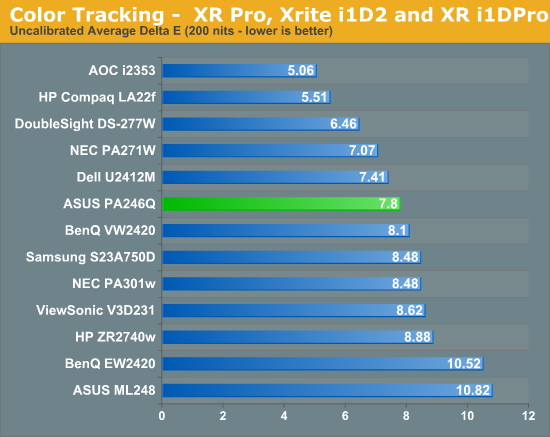
Out of the box in sRGB mode we see that performance isn’t any better or worse than other displays for the most part. However the grayscale is overall very good, and the primary colors are decent for the most part with dE values that are relatively low. If I’m judging the <5 claim based on this, the PA246Q might live up to expectations. Once I move into certain shades of blue, however, the dE really gets high, and so using the whole spectrum I can’t say that it manages <5 dE for the sRGB mode. Perhaps they are using a different dE formula than we are, or perhaps they are only claiming that white will be below 5, but using the same standard we apply to other vendors, the PA246Q isn't any better or worse out of the box than the competition.
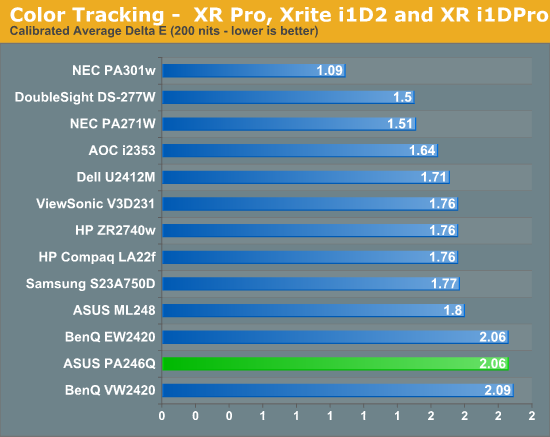
So out of the box the calibration seems fine but not exceptional, but does it calibrate well for those that need it? Overall the calibrated dE of 2.06 looks a little high, but when we examine the graph we see that the grayscale is much higher than any other display in the chart. This is a bit weird, and leads me to wonder how well the two-point grayscale calibrates and is handled internally. I set that for 100% and 30% as those should lead to a fairly accurate grayscale across the gamut, but here it seems to be good at 100% and then really ramp up. If the math is incorrect internally, this could lead to these issues where it has those two points correct, but determining the values for points between them is done incorrectly.
When I broke out the data more, the average dE for the color patches was 2.08 for the ASUS, which is almost equal to the overall value. For other monitors I had data for, the colors were on average 0.25 dE higher than the total dE with grayscale. So it seems that colors are better on the ASUS, but the grayscale is worse. In this case if you are doing photo editing, it might be a better choice than if you are using it for black and white work or even general-purpose work. With spreadsheets and word processing, you don’t notice a tint since the white is very good overall, but dark shadows can be off. So overall the performance of the ASUS PA246Q here was good for color and fairly poor for grayscale, which is different than almost any other display we have seen.

With 100 nits, the grayscale was much better and so the better colors led to a dE that was lower than with 200 nits. Because of this the ASUS seems to be a better performer for print work than for brighter rooms, but really the main area it fails is for black and white photo editing with a brighter screen.
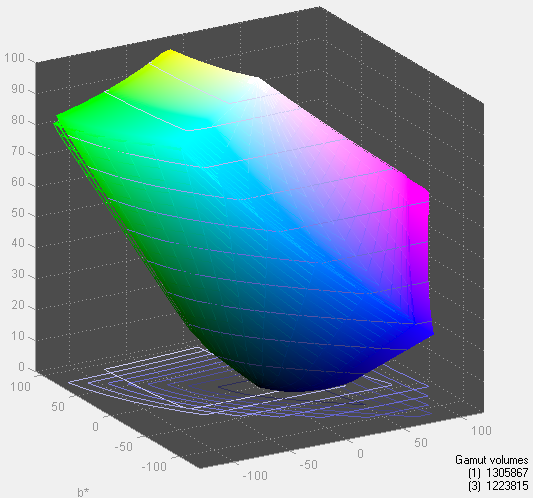
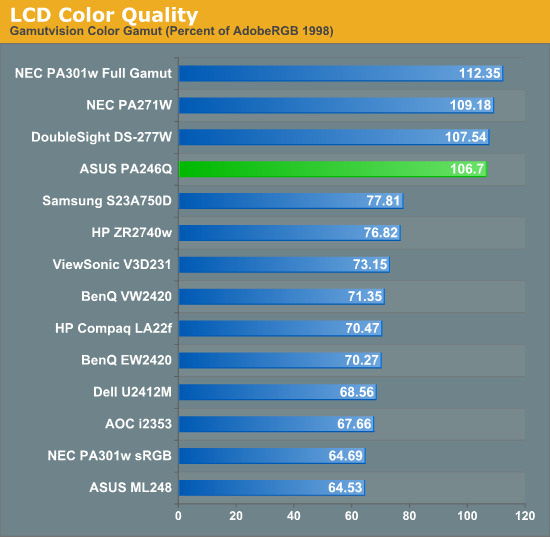
ASUS says they can do the full AdobeRGB gamut on this display and they aren’t lying. With almost 107% coverage it will work well for photographers and other professionals that need the larger gamut.


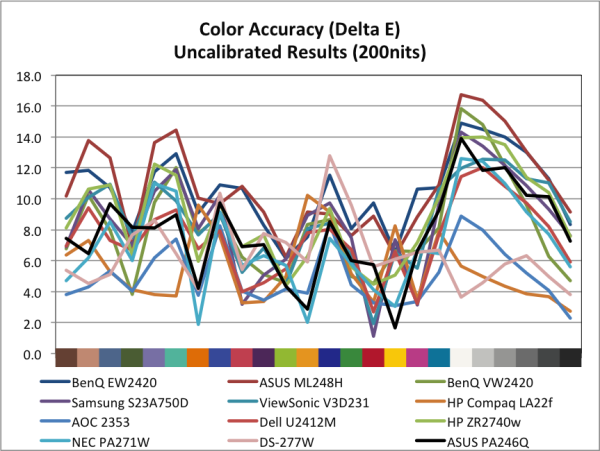
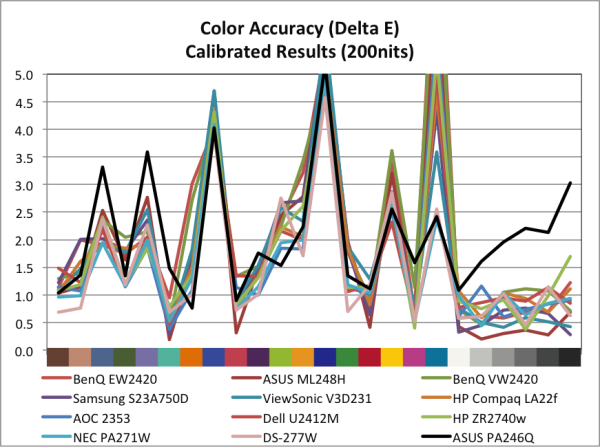









52 Comments
View All Comments
Leyawiin - Wednesday, July 4, 2012 - link
Just submitted my order - time for a quality monitor for the first time in my life!cheinonen - Thursday, July 5, 2012 - link
As I mentioned above, they're very different monitors. The PA246Q is a 10-bit panel with a full AdobeRGB color gamut from CCFL backlighting, and the PA248Q is an 8-bit panel with LED backlighting and only the sRGB gamut. It's a more mainstream panel than the PA246Q so for non-print and photo editing users, it might be a better choice, but they aren't practically the same other than size, resolution, and vendor.appliance5000 - Saturday, July 7, 2012 - link
The reviewed monitor is an 8 bit panel interpolated to simulate a 10 bit panel - a little dubious.Oxford Guy - Thursday, July 5, 2012 - link
Is this actually a 10-bit panel?Also, since sRGB mode on some wide gamut monitors works (U2410) and is completely broken on others, whenever you review a wide gamut monitor you should separate its performance in terms of sRGB content and AdobeRGB content. The way you lump them together with a "color quality" chart makes little sense. For those dealing with sRGB content, having a monitor exceed the sRGB space can actually lead to poor quality if the monitor doesn't have an effective sRGB emulation mode.
I would take a look at how prad.de and tftcentral separate sRGB and AdobeRGB modes in their reviews.
cheinonen - Friday, July 6, 2012 - link
I will take a look at that. I've only had a couple come through with AdobeRGB support so far, so I haven't setup a separate test section for it, but I can do that in the future.appliance5000 - Saturday, July 7, 2012 - link
I hear you on the srgb - I have an nec p221w (which is an excellent spectraview compatible monitor for about $400.00. With hardware cal the delta e is well under 1 for adobe rgb at a brightness of 140 cd/m2. I highly recommend it)But, being a wide spectrum (97% adobe rgb) srgb seems tough to calibrate for print. My question is : Isn't s-rgb used mainly to proof for web use, particularly for non color managed environments, in which case a delta e of 3 - 5 is fine? The point being that most people pull a monitor out of the box and turn it on for 5 years - there's no way to know what they're looking at.
aranyagag - Tuesday, December 11, 2012 - link
it clears eizo monitor test and other monitor tests which are supposed to weed out 8 bit monitors. Also I have an sRGB camera, which shows proper colours when the monitor is placed in rgb mode-- laparoscope.Dug - Wednesday, July 11, 2012 - link
I had always thought AdobeRGB was just a higher gamut allowing you to see for instance a raw file shot in AdobeRGB at its full potential. The problem is the assumption that this is better.I've found that most print shops don't have the correct profiles, don't use the embedded profile, etc.
I've gone down the expensive road of getting the correct monitor, printer, and color profiling both to print myself.
In all honesty its a pain in the ass with very little gain.
If everything isn't done just right then you end up with dull colors.
If everything is done right, there is a difference, but I wouldn't necessarily call it better. It may be more accurate, because you've been told it is, but it is subtle.
If you have to email, show on web, print to a printer without correct profile, etc you've wasted all your time if using AdobeRGB.
I kind of relate it to calibrated televisions. If anyone saw a true calibrated television, they probably wouldn't like it. It's very dull. Everyone likes a little extra contrast and run a little hot.
Sense the entire world runs on sRGB, I say stick with it. There's less chance for error and it will look good on anyone's monitor and printer.
CrimsonFury - Thursday, July 12, 2012 - link
Still using my 8 year old Lacie 22" CRT until something better comes along. 4:3 2048x1536 @85Hz. Still waiting for an LCD with that sort of pixel density around 24" in size.I dislike 27" and above screens, I find them too large for a comfortable viewing position. Also on the high res 27" - 30" panels pixels per inch are still lower than my old 22" CRT
AnnonymousCoward - Saturday, July 14, 2012 - link
Looks like a great attempt at a quality monitor. But when are we gonna get past the 60Hz barrier??? At least 80Hz framerate would be so much better.